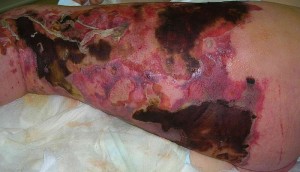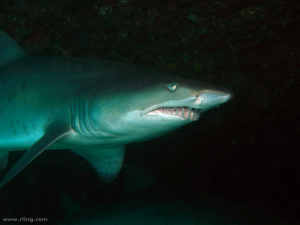Warning: Blog Post contains graphic images and video which may offend or disturb some viewers. Blogger does not take responsibility for any sudden onsets of nausea. Viewer discretion is advised.
What Is It?
Flesh-eating disease, or Necrotizing fasciitis as it is formally known, is actually a bacterial infection caused by several types of bacteria but most commonly, Streptococcus pyogenes. Invading by a very small wound, the bacteria will produce chemical toxins which begin to destroy tissues and muscles. Within a day, symptoms will begin to appear but they are mild at first and often mistaken as the flu with fever, nausea, and vomiting common. Eventually, the wound area will begin to swell and pain will increase. In the picture below, you can see the presence of gangrene or dead tissue in a leg with the disease.
Necrotizing fasciitities left leg. Image from Wikipedia.
Now, antibiotics will treat the disease in its early state but all too often, the disease is discovered too late in its progression. In that case, the only treatment is to remove the infected body parts. A few patients have gone to the hospital, only to wake up a few days later out of a medical coma to find themselves missing their limbs. About 20-30% of cases are fatal.
Check out this compelling video of a woman who was lucky enough to survive the disease but was not lucky enough to keep all her limbs.
“Flesh-eating disease took her arms and legs, but not her spirit.” Video posted by YouTube user druidhills2005.
Where Is It Today?
In New Zealand, cases of flesh-eating disease have actually been on the rise according to the Ministry of Health of New Zealand. In 1990, there were only about 10 cases of the disease but in 2006, there were more than 70 cases. New Zealand is a first world country just like Canada and the United States so this is some surprising news that should hit close to home.
Whoa! What Should I Do?
Don’t panic yet! The disease is still very rare and in Canada (with a population almost 8 times larger than New Zealand), only 90-200 cases are reported each year. However, it is still probably a pretty good idea to avoid it. To minimize your risk, Health Canada advises you to “take care of minor wounds and cuts” making sure to “wash the affected area in warm soapy water.” Additionally, if you do come in contact with someone you know that has been inflicted with the disease, see a doctor immediately. In general, take care of yourself. Those with a weakened immune system or with chronic diseases are particularly vulnerable.
References
Greenfield, R. & Shehnaz, S. (2008). Gangrene. emedicinehealth. Retrieved from http://www.emedicinehealth.com/gangrene/article_em.htm.
Health Canada. (2006). Flesh-eating Disease. Health Canada. Retrieved from http://www.hc-sc.gc.ca/hl-vs/iyh-vsv/diseases-maladies/flesh-chair-eng.php#mi.
Kirk, S. (2011). Fleash eating disease on the rise. stuff.co.nz. Retrieved from http://www.stuff.co.nz/manawatu-standard/5690711/Flesh-eating-disease-on-the-rise.
Ministry of Health, New Zealand. (2011). Retrieved from http://www.moh.govt.nz/moh.nsf.
Nationsonline. (2005). Countries of the First World. NationsOnline. Retrieved from http://www.nationsonline.org/oneworld/first_world.htm.
Stoppler, M. (2008). What Is a “Flesh-Eating” Bacterial Infection? MedicineNet.com. Retrieved from http://www.medicinenet.com/script/main/art.asp?articlekey=61933.
Worldatlas. (2010). Countries of the World. Worldatlas.Retrieved from http://www.worldatlas.com/aatlas/populations/ctypopls.htm.


